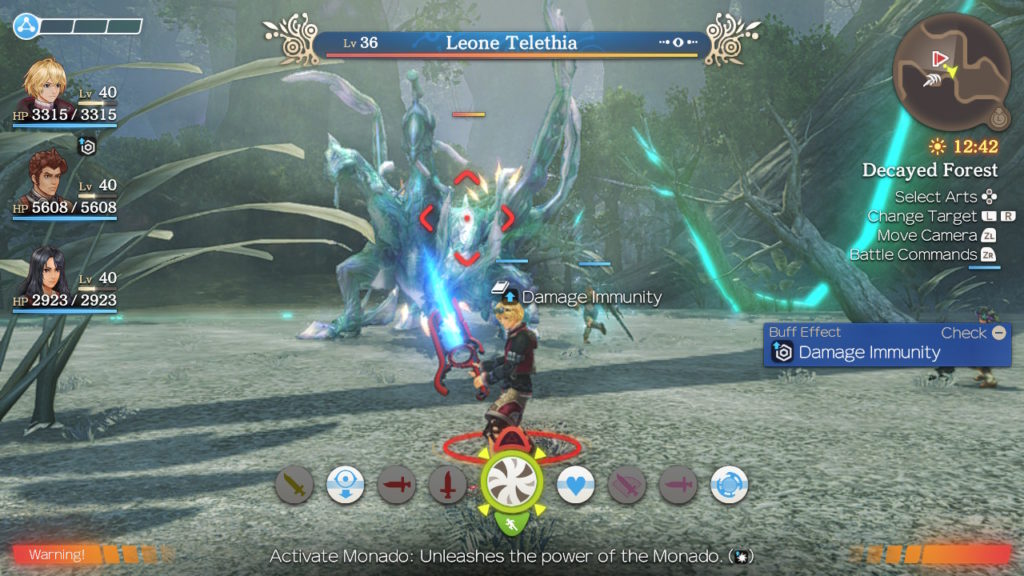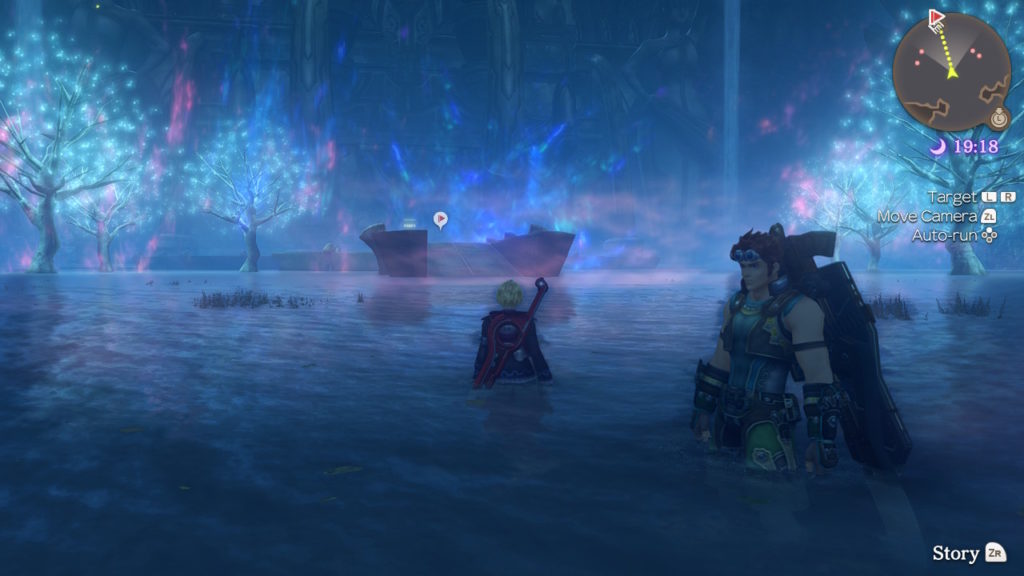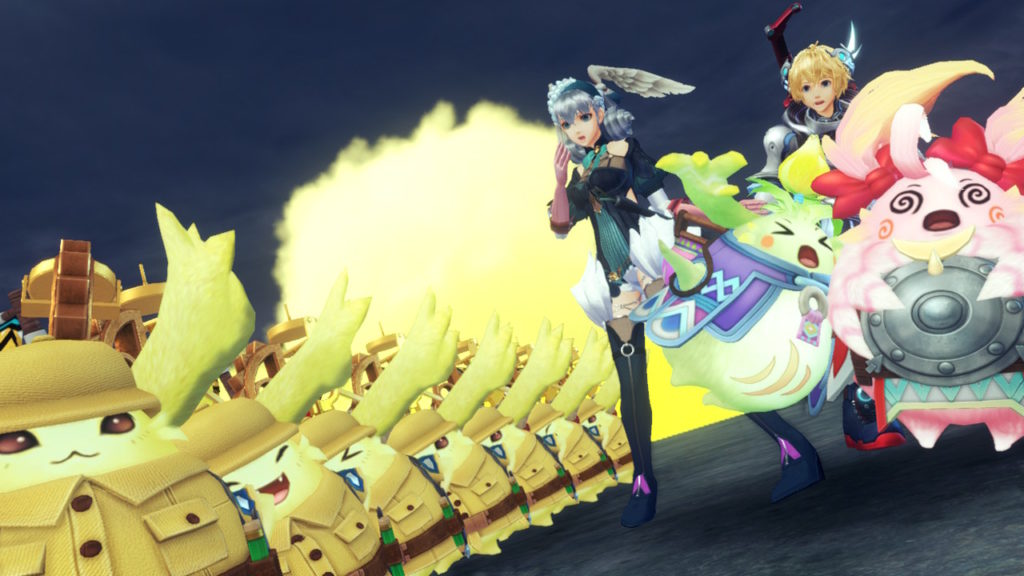- Genre: JRPG
- Platform: Switch
- Originally Available On: Wii, 3DS
So, this is admittedly the third time I’ve played this game. I knew I would enjoy it, I knew it would take a long time, and I knew what the experience would be like. However, it was interesting playing it after Xenoblade 2. It didn’t necessarily make the remake better or worse, but the big changes in combat for Xenoblade 2 are something that I think I now appreciate more having gone back to the older combat style. My ramblings here are generally going to reflect seeing the changes the series has gone through now that I’ve played the two book ends sort of back to back.

Combat in the remake is the same as it was in the original. Your artes are lined up in a row to be used. Some artes are attacks, some are buffs or debuffs, some are defensive maneuvers, etc. Some of them are based on positioning (ex: bonus damage if attacking from behind). Some are used in tandem to effect the enemy (ex: Break -> Topple -> Stun). The basics that are there are the same that have been in the Xenoblade series the whole time.
What surprised me going back now that I’ve played Xenoblade 2 is how much I wish they’d have applied that game’s combat system to the remake. Ignoring some of the features that are definitely tied to the Xeno 2 story, the core change to that combat is that instead of a bar of artes that you scroll through, each attack is tied to a hard button – either on the d-pad or on the face buttons. This would have made the combat in this remake so much more fluid. You’ve got 8 buttons that could be used, 8 artes that you can assign anyway, and then a center activation on each character that could easily be applied to one of the shoulder buttons. Instead, you’re stuck doing a scroll to get to the arte that you want to use, while at the same time trying to juggle movement.
It also caught me a bit off guard that I never hit a point where I really felt a need to grind. I’m not sure if this is just because I’m generally familiar with the game, or if they did a rebalance pass, but balance was almost always in line with my expectations. Bosses felt reasonably balanced for where I expected to be in the game. If I was hitting a point where I was feeling a bit pressured, there was generally enough side quests around to give me boosts. I was generally collecting enough general stuff to keep up with money needed to grab the relevant current set of gear. It was just kind of a nice level playing field for the bulk of the game. I admittedly dropped it down to easy at the end, but not because I was frustrated of the grind like 2 or X. I was simply at a point where I wanted to see the remastered finish and epilogue content, rather than go through a boss gauntlet I’d already been through before.

On the other hand, boy do I really not miss the complexity of the systems in place in Xenoblade 2. That’s not to say that this game was ever really that simple, but it still only has three real forms of progression – XP for levels, AP for leveling up artes, and SP for leveling up passive skills. This is a far simpler game than the Excel simulation that Xeno 2 ultimately became. If there’s anything that really is still a bit of a chore to manage, it’s the amount of side questing involved.
That said, the overall UX for this is much improved over the original game anyway. Getting to your quest list is super fast (d-pad down). The in-world indication of where quest items or quest kills are is significantly improved. Generally speaking, it’s a lot more obvious what I should be doing at any point, and far quicker for me to change my focus to a different side quest with a few clicks.

There’s also some bonus points for how easy it was for me to change the cosmetic look of the party in the remake. Buying a piece of gear once permanently allows you to equip its cosmetic look to the characters it applies to. This is a super nice change, since your party can very rapidly turn into a multicolor shit show with all the random gear you’ll end up finding. I set my party’s look pretty early on to be consistent with roughly where they started, with a few minor color variations that I preferred, and stuck with it. On the surface, this may seem like a small feature, but I was always more of a fan of the numbers behind gear in JRPGs, and typically less of a fan of the visual impact in games that supported it, so finding my look and sticking to it is one of those things I really appreciate.

However, the real reason I suspect most people will want to replay this is for the Future Connected epilogue. This one was interesting in that it’s substantial, but not nearly as substantial as the Torna expansion for 2. It provides some nice story closure specifically for Melia, but not much else for the rest of the gang. It adds an interesting mechanic with the Nopon Ponspector horde that replaces chain attacks, but also significantly scales back your party flexibility. I suppose ultimately, it was a nice way for me to wrap up my gameplay of the remake, but it left me wanting to see more of what happened to the rest of the party. There may be some potential for them to add more of these epilogues to the game if they need to stretch the schedule before whatever Xeno project comes next, but I’m not sure if I’d recommend playing through an entire long JRPG again unless you’re really as big a fan of the series as I am.
Remakes are always a tough one, but in cases like Xenoblade I’m pretty happy about it. Beyond exposing the game to a much different audience than the previous go arounds, it’s just nice to hop into a game I loved in a way that is significantly better looking. This has continued my sort of run of JRPG remakes that I’ve been doing lately, and this is probably the safest of my recent bunch, sticking to the original framework entirely – FF7R was a distinct explosion, and Trials of Mana was similar in gameplay, but much different in visual style. However, it being safer didn’t make it worse. The game largely still works great. Would I have liked to see them take some risks and make combat smoother with lessons learned from 2? Ya. Am I glad to see that they didn’t add heaps of new systems? Even larger ya. This game wasn’t accidentally a 92 metacritic its first go around, and that shows. This game has aged remarkably well, and with a fresh coat of paint it’s still going to be worth playing for newcomers, and returning players may just take it as an opportunity to revisit a game they loved.
